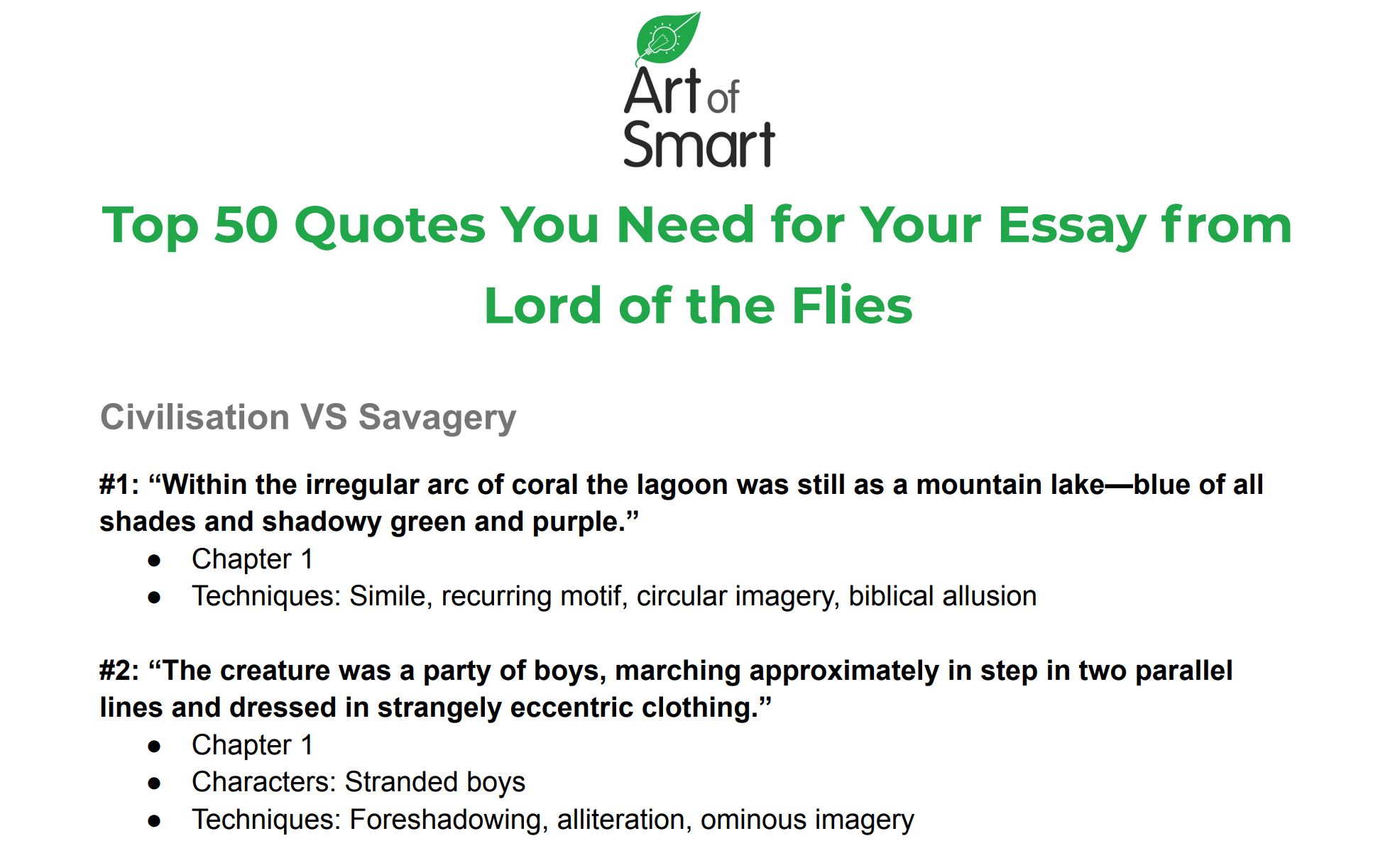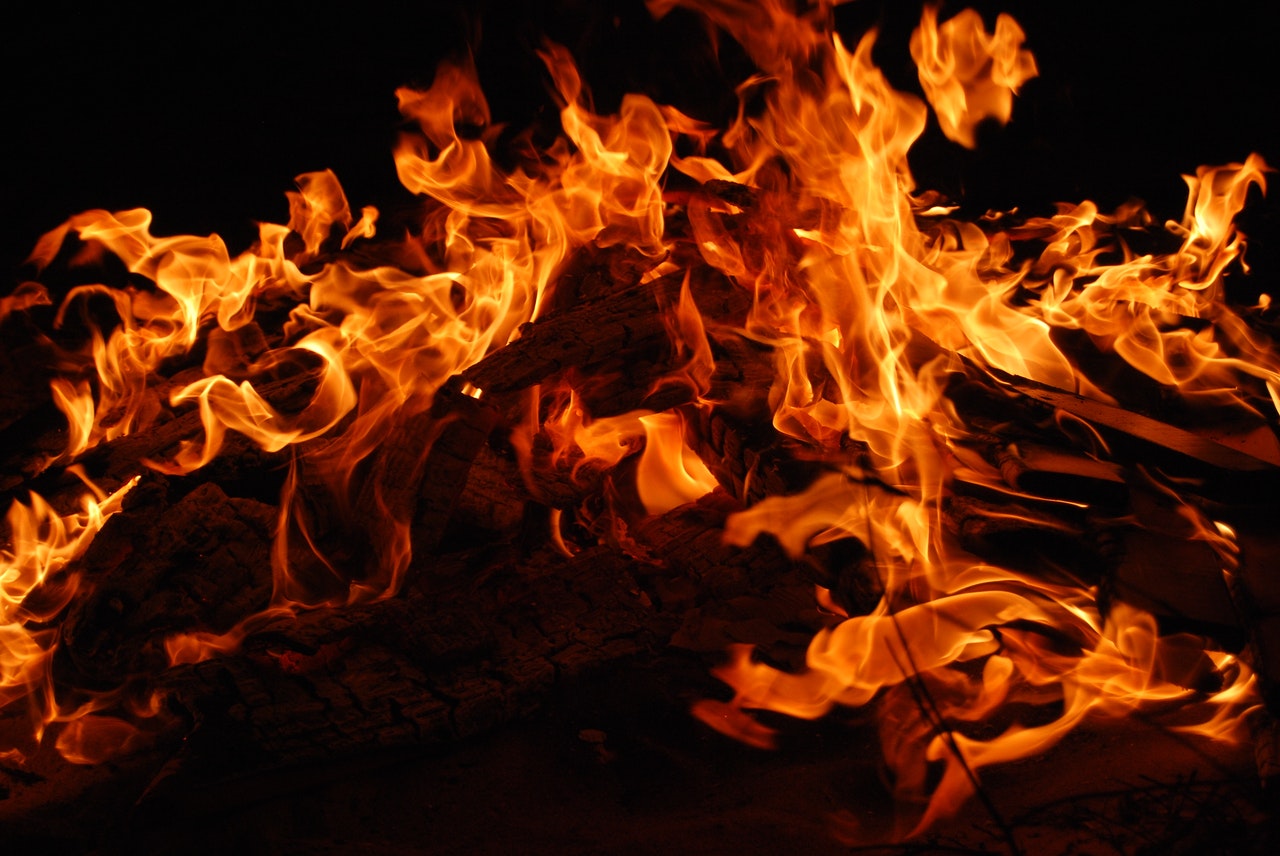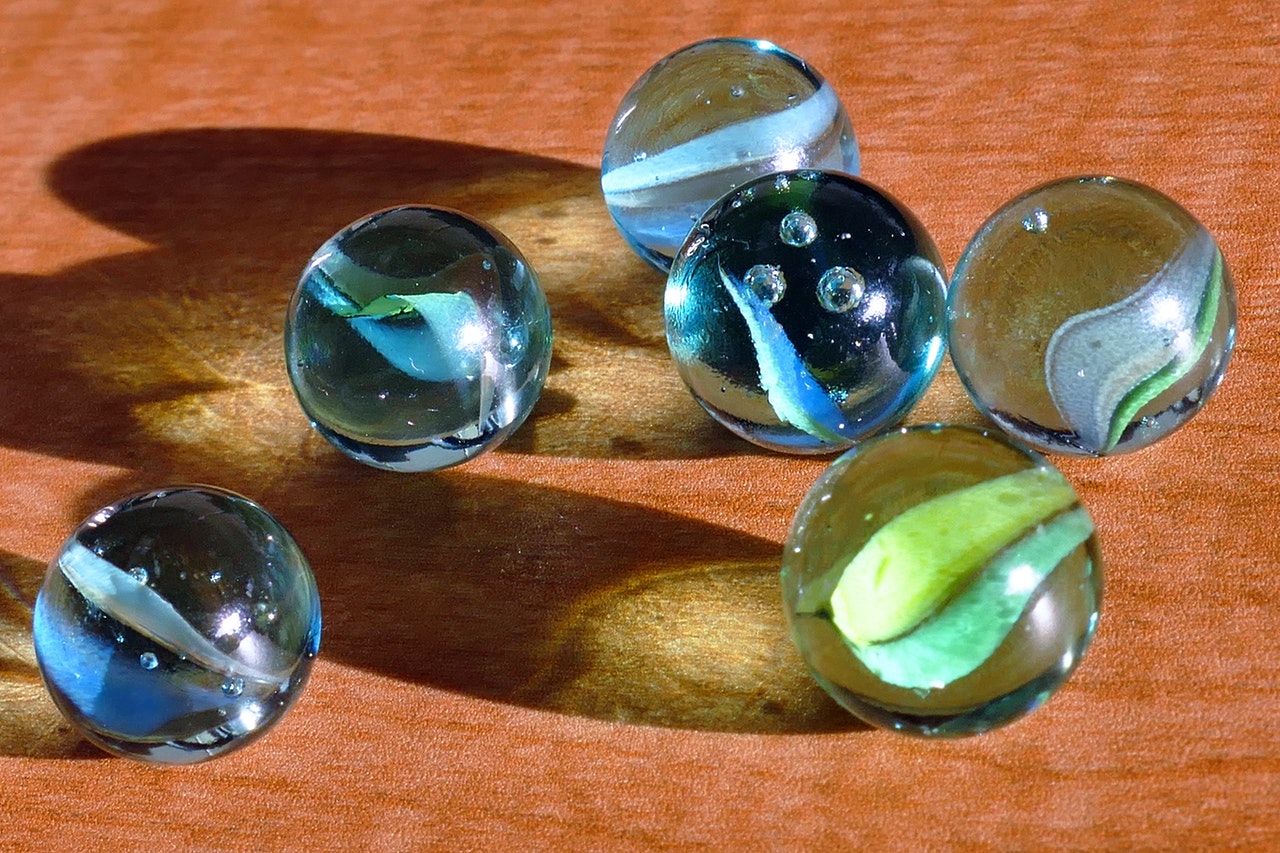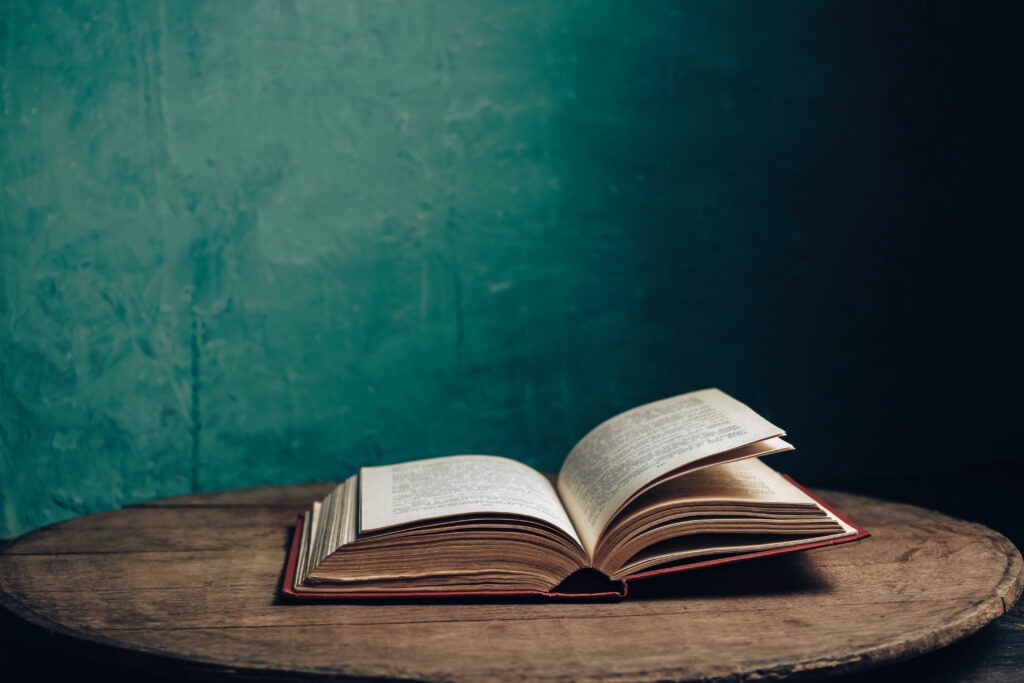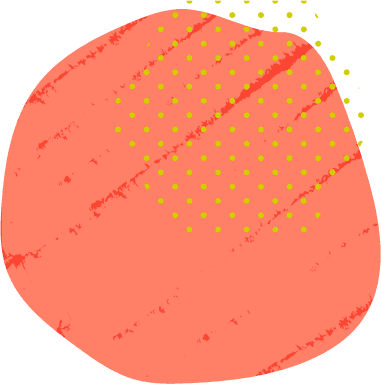Got an essay to write on Lord of the Flies, but aren’t sure which quotes you should analyse from the text?
We’ve made your task a little simpler with our list of 50 quotes and 4 different themes explored in Lord of the Flies! You’ll also be able to download a list of these quotes to have on hand.
What are you waiting for? Get scrolling to read through our list of quotes from Lord of the Flies!
Lord of the Flies Quotes About Savagery
Innocence
Lord of the Flies Quotes About Conflict and Humanity’s Inherent Evil
Identity
Lord of the Flies Quotes About Savagery
#1: “Within the irregular arc of coral the lagoon was still as a mountain lake—blue of all shades and shadowy green and purple.”
- Chapter 1
- Techniques: Simile, recurring motif, circular imagery, biblical allusion
#2: “The creature was a party of boys, marching approximately in step in two parallel lines and dressed in strangely eccentric clothing.”
- Chapter 1
- Characters: Stranded boys
- Techniques: Foreshadowing, alliteration, ominous imagery
#3: “This last piece of shop brought sniggers from the choir, who perched like black birds on the criss-cross trunks and examined Ralph with interest.”
- Chapter 1
- Characters: The choir, Ralph
- Techniques: Simile, ominous imagery, foreshadowing
#4: “Roger gathered a handful of stones and began to throw them. Yet there was a space round Henry, perhaps six yards in diameter, into which he dare not throw. Here, invisible yet strong, was the taboo of the old life. Round the squatting child was the protection of parents and school and policemen and the law.”
- Chapter 4
- Characters: Roger, Henry
- Techniques: Polysyndeton, foreshadows Rogers killings later in the text
#5: “Kill the pig. Cut her throat. Spill her blood.”
- Chapter 4
- Characters: Hunters
- Techniques: Repetition, parataxis, incantatory tone
Analysis:
The quote, “Kill the pig. Cut her throat. Spill her blood,” is a chant that the boys repeat while they are hunting. The phrase represents the boys’ descent into savagery and the loss of their civilised values. The repetition of the phrase creates a ritualistic, almost religious quality to the boys’ actions, as they become more and more removed from the norms of society. The phrase also has symbolic meaning.
The pig represents innocence and goodness, and the boys’ act of killing it represents their rejection of these values. The phrase also foreshadows the violence and bloodshed that will occur later in the novel, as the boys’ primal instincts take over. Overall, the quote represents the loss of civilisation and the rise of barbarism in the novel. It is a powerful example of how language can be used to convey the themes of a story and the inner workings of its characters.
#6: “Ralph took the conch from where it lay on the polished seat and held it to his lips; but then he hesitated and did not blow. He held the shell up instead and showed it to them and they understood.”
- Chapter 6
- Characters: Ralph
- Techniques: Conch motif, deliberate vagueness
#7: “This head is for the beast. It’s a gift.”
- Chapter 8
- Characters: Jake
- Techniques: Symbolism, juxtaposition
Analysis:
The quote, “This head is for the beast. It’s a gift,” is spoken by one of the boys, Jack, after his group kills a pig. Jack cuts off the pig’s head and offers it to the “beast” as a gift to appease it. The phrase represents the boys’ descent into savagery and their willingness to sacrifice the innocent in order to protect themselves from a perceived threat.
The phrase also has symbolic meaning. The pig’s head represents the boys’ descent into barbarism and the loss of their humanity. It symbolises the evil and darkness that is within all of them, and the willingness to give into it.
Overall, the quote represents the boys’ loss of morality and their belief in a false idea, the “beast,” which is a symbol of their own inner demons. It is a powerful example of how language can be used to convey the themes of a story and the inner workings of its characters.
#8: “A circling movement developed and a chant. While Roger mimed the terror of the pig, the littluns ran and jumped on the outside of the circle.”
- Chapter 9
- Characters: Hunters
- Techniques: Circular imagery, recurring motif, symbolism
#9: “The mouth of the new circle crunched and screamed”
- Chapter 9
- Characters: Hunters
- Techniques: Personification, circular imagery, recurring motif
#10: “Piggy and Ralph, under the threat of the sky, found themselves eager to take a place in this demented but partly secure society. They were glad to touch the brown backs of the fence that hemmed in the terror and made it governable.”
- Chapter 9
- Characters: Ralph, Piggy, the Hunters
- Techniques: Pathetic fallacy, climax, personification
#11: “But they’ll be painted! You know how it is.”
The others nodded. They understood only too well the liberation into savagery that the concealing paint brought.
- Chapter 11
- Characters: Eric (speaker), Ralph, Piggy, Sam
- Technique: Emphatic language, dialogue
#12: “The rock struck Piggy a glancing blow from chin to knee; the conch exploded into a thousand white fragments and ceased to exist … Piggy fell forty feet and landed on his back across the square red rock in the sea. His head opened and stuff came out and turned red. Piggy’s arms and legs twitched a bit, like a pig’s after it has been killed.”
- Chapter 11
- Characters: Piggy
- Techniques: Simile, symbolism, anticlimax
#13: “Then the sea breathed out again in a long slow sigh, the water boiled white and pink over the rock; and when it went, sucking back again, the body of Piggy was gone.”
- Chapter 11
- Characters: Piggy
- Techniques: Personification, natural imagery, sibilance
Analysis:
The quote describes the death of one of the main characters, Piggy. In this scene, a group of boys push a large rock off a cliff, which lands on Piggy, killing him. The quote describes the aftermath of this event, as the sea reacts to the violence that has taken place.
The phrase “the sea breathed out again in a long slow sigh” creates a sense of calm and reflection after the chaos that has just occurred. The “white and pink” water boiling over the rock represents the blood of Piggy, and the image of the water “sucking back again” symbolises the sudden and brutal loss of life.
Overall, the quote is a powerful description of the aftermath of violence and the effect it has on the natural world. It is a reminder of the tragic consequences that can occur when humans give into their darkest impulses and turn on each other.
Jack Quotes from Lord of the Flies about Savagery
#14: “I agree with Ralph. We’ve got to have rules and obey them. After all, we’re not savages. We’re English, and the English are best at everything. So we’ve got to do the right things.”
- Chapter 2
- Characters: Jack (speaker)
- Techniques: Foreshadowing, irony, first person plural, short syntax
#15: “The chief was sitting there, naked to the waist, his face blocked out in white and red. The tribe lay in a semicircle before him.”
- Chapter 10
- Characters: Jack
- Techniques: Circular imagery, recurring motif
#6: “Bollocks to the rules! We’re strong—we hunt! If there’s a beast, we’ll hunt it down! We’ll close in and beat and beat and beat—!”
- Chapter 5
- Characters: Jack (speaker)
- Techniques: Repetition, emphatic language, call to action
Simon Quotes from Lord of the Flies about Savagery
#17: “Maybe there is a beast… Maybe it’s only us.”
- Chapter 5
- Characters: Simon (speaker), assembly of boys
- Techniques: Repetition, dialogue, reflective and speculative tone, paradox
Analysis:
The quote is spoken by one of the boys, Simon, who is the most insightful and spiritually-minded of the group. Simon is suggesting that the “beast” they fear may not be an external creature, but rather the darkness and savagery within themselves.
The quote is a key moment in the book, as it marks a turning point in the boys’ beliefs. Until this point, the boys have been united in their fear of the “beast.” Simon’s insight forces them to confront the possibility that their greatest enemy is not some external force, but rather the evil that lies within themselves.
The phrase “Maybe there is a beast… Maybe it’s only us” is a powerful commentary on human nature and the potential for evil that exists within all of us. It suggests that the true enemy is not something external, but rather our own darker impulses and tendencies. It is a reminder that we must always be vigilant against our own worst instincts, in order to maintain a civilised and just society.
#18: “He opened his eyes quickly and there was the head grinning amusedly in the strange daylight, ignoring the flies, the spilled guts, even ignoring the indignity of being spiked on a stick.”
- Chapter 8
- Character: Simon
- Techniques: Personification, repetition, symbolism
#19: “You knew, didn’t you? I’m part of you? Close, close, close! I’m the reason why it’s no go? Why things are what they are?”
- Chapter 8
- Characters: Lord of the Flies, Simon
- Techniques: Rhetorical questions, epizeuxis, exclamatory remark, intentional vagueness
#20: “Then, amid the roar of bees in the afternoon sunlight, Simon found for [the littluns] the fruit they could not reach, pulled off the choicest from up in the foliage, passed them back down to the endless, outstretched hands.”
- Chapter 3
- Characters: Simon, littluns
- Techniques: Hyperbolic language, natural imagery, character foil
Ralph Quotes from Lord of the Flies about Savagery
#21: “He swung to the right, running desperately fast, with the heat beating on his left side and the fire racing forward like a tide.”
- Chapter 12
- Characters: Ralph
- Techniques: Simile, recurring fire motif, juxtaposition
#22: “Ralph launched himself like a cat; stabbed, snarling, with the spear, and the savage doubled up.”
- Chapter 12
- Characters: Ralph
- Techniques: Simile, sibilance, feline imagery
#23: “The world, that understandable and lawful world, was slipping away.”
- Chapter 5
- Characters: Ralph
- Techniques: Repetition, reflective tone
#24: “We’re all drifting and things are going rotten. At home there was always a grownup. Please, sir; please, miss; and then you got an answer. How I wish!”
- Chapter 5
- Characters: Ralph
- Techniques: Repetition, exclamatory remark
Innocence
#25: “Then, with the martyred expression of a parent who has to keep up with the senseless ebullience of the children, he picked up the conch, turned toward the forest, and began to pick his way over the tumbled scar.”
- Chapter 2
- Characters: Piggy
- Techniques: Metaphor, motif of the conch, symbolism of the island’s scar
#26: “Apart from food and sleep, they found time for play, aimless and trivial, in the white sand by the bright water. They cried for their mothers much less often than might have been expected; they were very brown, and filthily dirty.”
- Chapter 4
- Characters: The littluns
- Techniques: Diction, third-person omniscient narrator, juxtaposing adjective use
#27: “A spring had been tapped, far beyond the reach of authority or even physical intimidation. The crying went on, breath after breath, and seemed to sustain him upright as if he were nailed to it.”
- Chapter 5
- Characters: Percival
- Techniques: Metaphor, biblical allusion, repetition
#28: “Even the sounds of nightmare from the other shelters no longer reached him, for he was back to where came from, feeding the ponies with sugar over the garden wall.”
- Chapter 6
- Characters: Ralph
- Techniques: Domesticated imagery of a pony, juxtaposition, dreamscape
#29: “A semicircle of little boys, their bodies streaked with colored clay, sharp sticks in their hands, were standing on the beach making no noise at all.”
- Chapter 12
- Characters: The hunters, Ralph
- Techniques: Circular imagery, sibilance
#30: “A little boy who wore the remains of an extraordinary black cap on his red hair and who carried the remains of a pair of spectacles at his waist, started forward, then changed his mind and stood still.”
- Chapter 12
- Characters: Jack
- Techniques: Intentional omittance of name, motif of the spectacles
#31: “And in the middle of them, with filthy body, matted hair, and unwiped nose, Ralph wept for the end of innocence, the darkness of man’s heart, and the fall through the air of the true, wise friend called Piggy.”
- Chapter 12
- Characters: Ralph
- Techniques: Listing, evocative adjectives, juxtaposition
Lord of the Flies Quotes About Conflict and Humanity’s Inherent Evil
#32: “The ground beneath them was a bank covered with sparse grass, torn everywhere by the upheavals of fallen trees, scattered with decaying coconuts and palm saplings. Behind this was the darkness of the forest proper and the open space of the scar.”
- Chapter 1
- Characters: Ralph, Piggy
- Techniques: Sibilance, descriptive imagery, contrast between images of decay (coconuts) and growth (saplings)
#33: “This time Ralph expressed the intensity of his emotion by pretending to knock Simon down; and soon they were a happy, heaving pile in the under-dusk.”
- Chapter 1
- Characters: Ralph, Simon, Jack
- Techniques: Alliteration, foreshadowing of Simon’s death, juxtaposition
#34: “Here was a coral island. Protected from the sun, ignoring Piggy’s ill-omened talk, he dreamed pleasantly.”
- Chapter 1
- Characters: Ralph, Piggy
- Techniques: Biblical allusion
Analysis:
The phrase “Here was a coral island” refers to the fact that the island is made of coral, which is a type of rock-like material that forms over long periods of time in warm, shallow waters. This detail is important because it sets the scene for the idyllic, almost dreamlike quality of the island.
The phrase “Protected from the sun” suggests that the island is a haven from the harsh realities of the outside world. The boys have been through a traumatic experience, having been stranded on the island with no adult supervision. The island provides a sense of safety and comfort, at least for the moment.
The phrase “Ignoring Piggy’s ill-omened talk” suggests that the character Piggy is seen as a pessimistic voice among the group. He is constantly warning the other boys about the dangers of their situation, but Ralph chooses to ignore him and enjoy the moment.
The phrase “he dreamed pleasantly” suggests that Ralph is in a state of blissful reverie, lost in the beauty of the island and the moment. This is a significant contrast to the violence and chaos that will come to dominate the boys’ experience on the island.
Overall, the quote sets up a contrast between the idyllic beauty of the island and the darker realities that the boys will have to face. It also highlights the different perspectives among the boys and the varying levels of optimism and pessimism among them.
#35: “The pile was so rotten, and now so tinder-dry, that whole limbs yielded passionately to the yellow flames that poured upwards and shook a great beard of flame twenty feet in the air”
- Chapter 2
- Techniques: Personification of the fire, foreshadowing
#36: “He began to dance and his laughter became a bloodthirsty snarling.”
- Chapter 4
- Characters: Jack
- Techniques: Contrast, canine imagery
#37: “His mind was crowded with memories; memories of the knowledge that had come to them when they closed in on the struggling pig, knowledge that they had outwitted a living thing, imposed their will upon it, taken away its life like a long satisfying drink.”
- Chapter 4
- Characters: Jack
- Techniques: Simile, third-person omniscient narrator, anadiplosis
#38: “I know there isn’t no beast—not with claws and all that, I mean—but I know there isn’t no fear, either…Unless we get frightened of people.”
- Chapter 5
- Characters: Piggy
- Techniques: Foreshadowing ensuing savagery, incorrect grammar, Piggy as a symbol for pragmatism
#39: “Simon found he was looking into a vast mouth. There was blackness within, a blackness that spread.”
- Chapter 8
- Characters: Simon
- Techniques: Repetition, symbolism, personification
#40: “Which is better–to have laws and agree, or to hunt and kill?”
- Chapter 11
- Characters: Piggy (speaker), Hunters
- Techniques: Question, repetition, diction, contrast
#41: “Her bows [were] hauled up and held by two ratings. In the stern-sheets another rating held a sub-machine gun.”
- Chapter 12
- Characters: Naval officers
- Techniques: Female pronoun, military jargon, recurring motif of violence
Identity Quotes from Lord of the Flies
#42: “I could swim when I was five. Daddy taught me. He’s a commander in the Navy. When he gets leave he’ll come and rescue us. What’s your father?”
- Chapter 1
- Characters: Ralph (speaker), Piggy
- Techniques: Question, boasting tone, short syntactical form
#43: “The smaller boys were known by the generic title of “littluns.”
- Chapter 3
- Techniques: Metonymy
#44: “The mask was a thing on it’s own, behind which Jack hid, liberated from shame and self-consciousness.”
- Chapter 4
- Characters: Jack
- Technique: Symbolism of the mask, sibilance, juxtaposition of hiding and being liberated
#45: “Jack planned his new face. He made one cheek and one eye-socket white, then he rubbed red over the other half of his face and slashed a black bar of charcoal across from right ear to left jaw.”
- Chapter 4
- Characters: Jack
- Techniques: Symbolism, diction choice (volatility of word slashed)
#46: “Percival Wemys Madison, The Vicarage, Harcourt St. Anthony, Hants, telephone, telephone, tele-“
- Chapter 5
- Characters: Percival
- Techniques: Listing, repetition, incantatory tone, disrupted syntax
#47: “I’m chief,” said Ralph, “because you chose me. And we were going to keep the fire going. Now you run after food—”
- Chapter 9
- Characters: Ralph (speaker), Jack
- Techniques: Assertive language, dialogue, disrupted sentence, symbolism
#48: “Someone was throwing stones: Roger was dropping them, his one hand still on the lever. Below him, Ralph was a shock of hair and Piggy a bag of fat.”
- Chapter 11
- Characters: Roger, Ralph, Piggy
- Techniques: Metaphor, religious imagery, hyperbole
Piggy Quotes from Lord of the Flies about Identity
#49: “What are we? Humans? Or animals? Or savages? What’s grownups going to think?”
- Chapter 5
- Characters: Piggy
- Techniques: Hypothetical questions, anaphora, incorrect grammar
#50: “You could see now that he might make a boxer, as far as width and heaviness of shoulders went, but there was a mildness about his mouth and eyes that proclaimed no devil.”
- Chapter 1
- Characters: Piggy
- Techniques: Metaphor, biblical allusion, third-person omniscient narrator
#51 (bonus!): “They used to call me Piggy!”
- Chapter 1
- Characters: Piggy (speaker), Ralph
- Techniques: Emphatic language, dialogue, use of insults
On the hunt for quotes from other texts?
Check out our list of quotes for the following texts:
- The Merchant of Venice
- Frankenstein
- Pride and Prejudice
- Blade Runner
- Hamlet
- To Kill a Mockingbird
- Never Let Me Go
- Things Fall Apart
- One Flew Over the Cuckoo’s Nest
- Jasper Jones
- The Tempest
Are you looking for some extra help with your analysis of Lord of the Flies quotes?
We have an incredible team of English tutors and mentors!
We can help you master your analysis of Lord of the Flies by taking you through the summary, key characters, quotes and themes. We’ll also help you ace your upcoming English assessments with personalised lessons conducted one-on-one in your home, online or at one of our state of the art campuses in Hornsby or the Hills!
We’ve supported over 8,000 students over the last 11 years, and on average our students score mark improvements of over 20%!
To find out more and get started with an inspirational English tutor and mentor, get in touch today or give us a ring on 1300 267 888!
Jessica Arentz is a Content Writer at Art of Smart and an undergraduate student at the University of Sydney where she studies a Bachelor of Arts/Advanced Studies (Media and Communications) (Marketing). She currently volunteers at 2SER community radio station as a producer and newsroom reader. When not writing, you can find Jess searching the web for cheap flights or spending her days with her head buried deep in a book.


